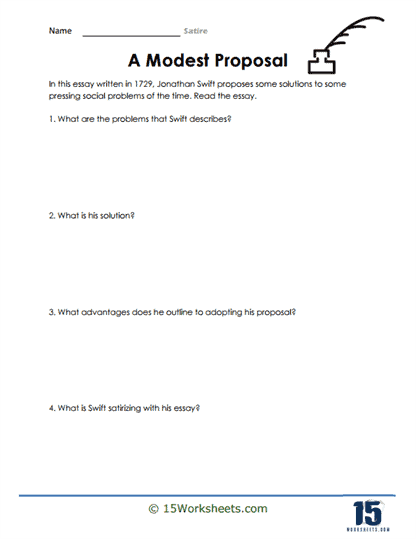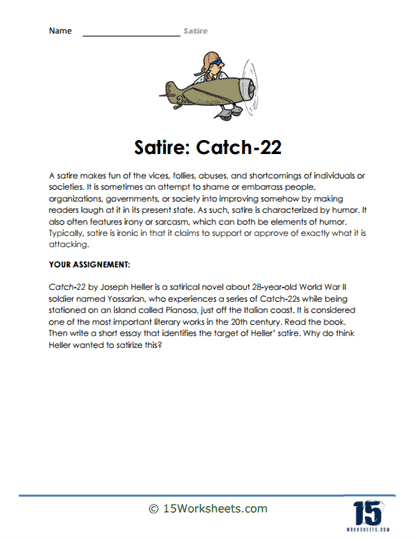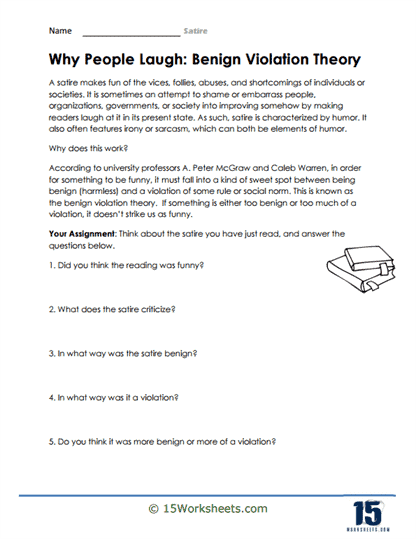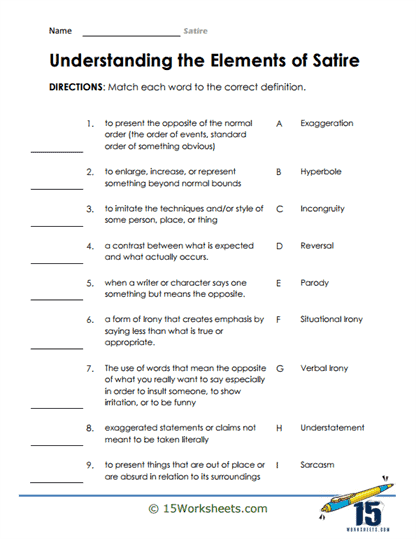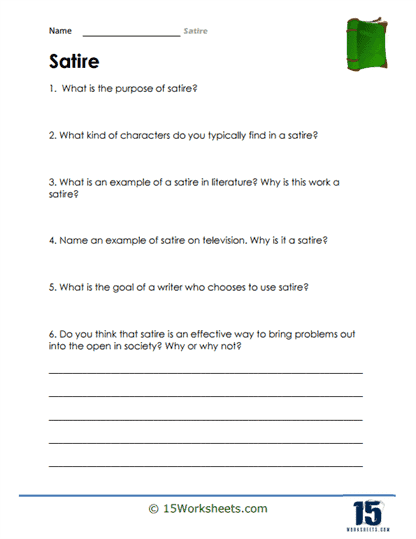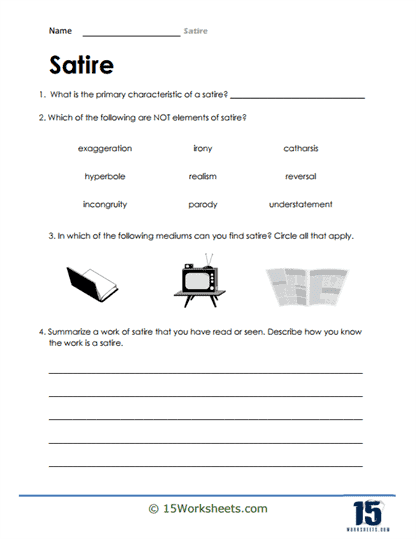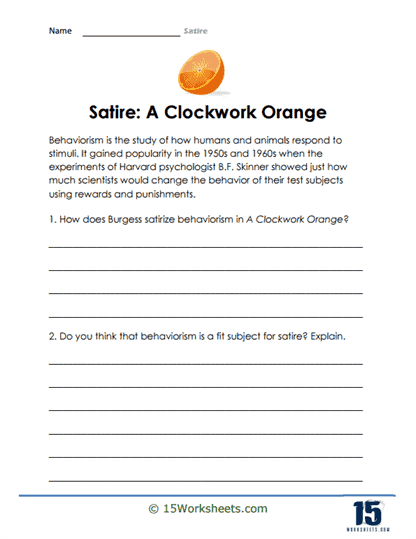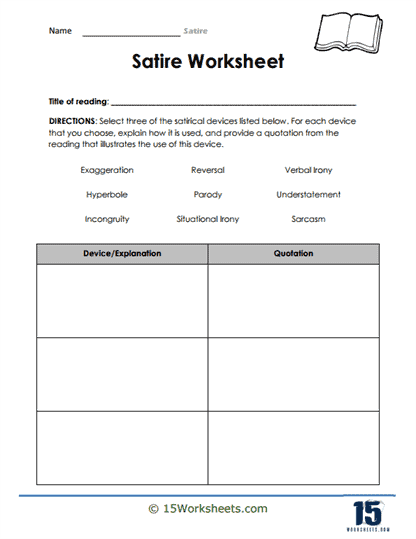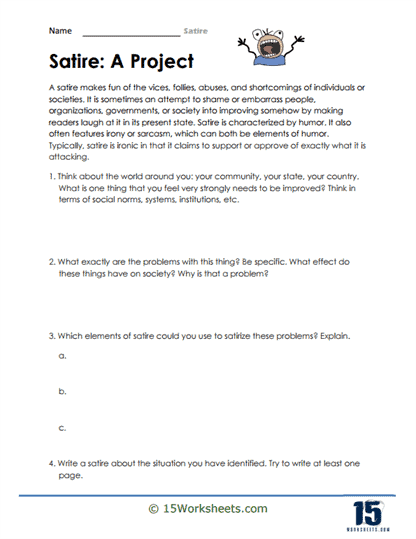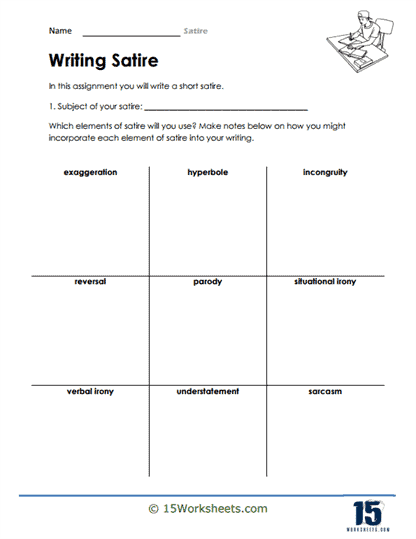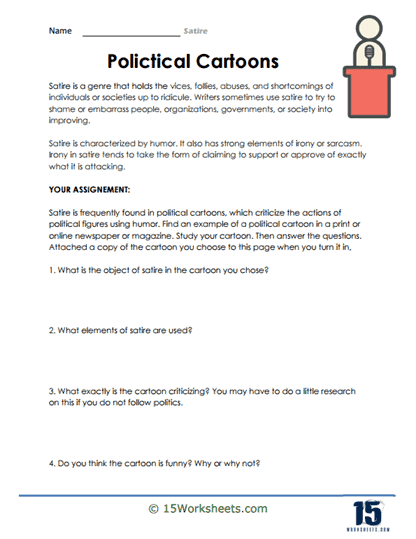Satire Worksheets
All About These 15 Worksheets
Satire, the use of humor, irony, or sarcasm to critique or ridicule human folly and vices, is a powerful and thought-provoking form of social commentary and artistic expression. Understanding satire is not only important for literary and cultural appreciation but also for fostering critical thinking, media literacy, and the ability to engage with complex societal issues. This collection of 15 worksheets is designed to introduce students to the world of satire, helping them grasp the importance of this literary genre, recognize its various forms, and develop their own satirical analysis and creative writing skills.
What Are Satire Worksheets?
Satire worksheets can be used by students to better understand and analyze the concept of satire. Satire is a literary device where humor, irony, or exaggeration is used to criticize or mock something such as individuals, institutions, or societal norms. Satire can be found in various forms of media, including literature, plays, television shows, and even political cartoons.
Satire worksheets might contain a number of exercises aimed at helping students identify and understand satire:
Identification – These exercises might include short passages, cartoons, or clips from movies or television shows. Students will be asked to identify whether or not the content is satirical and explain their reasoning. This can help students to understand the humor, exaggeration, and criticism that characterizes satire.
Understanding Satirical Techniques – Satire often uses techniques like irony, parody, hyperbole, and understatement. Worksheets might contain exercises where students must identify these techniques in examples of satire.
Analyzing Satire – Some exercises might present a piece of satire and ask the student to analyze what is being criticized or mocked and why. For example, students might be presented with a satirical political cartoon and asked to identify the social issue or political event it’s commenting on.
Creation – In some cases, students might be asked to create their own piece of satire. This could be a short written piece, a cartoon, or even a mock advertisement. This exercise can help students to understand how satire can be used to make a point about an issue or topic in a creative, engaging way.
These exercises help students to understand not just what satire is, but why and how it’s used. This can lead to greater media literacy and critical thinking skills, as students learn to identify and analyze the implicit messages in satirical works.
What is the Literary Device of Satire?
Satire is a genre of literature, and sometimes graphic and performing arts, that uses humor, irony, exaggeration, or ridicule to expose, critique, and mock human vices, follies, shortcomings, or abuses, often in the context of contemporary politics, societal norms, and other topical issues. Satire can range from light, playful, and humorous to dark, biting, and sharp, depending on the author’s intent and the subject matter.
Defining Features of Satire
Satire primarily uses humor and irony to convey its message, but it is humor with a purpose. It seeks not merely to entertain but to provide insightful criticism, to provoke thought, and often to promote change. Satire works by employing several literary devices, such as hyperbole, understatement, parody, and sarcasm. The ultimate aim is to point out the absurdity or the moral shortcomings in the subject matter, forcing readers or viewers to question and reconsider accepted norms and beliefs.
Examples of Satire in Literature
“Gulliver’s Travels” by Jonathan Swift
One of the most famous satirical works in literature is Jonathan Swift’s “Gulliver’s Travels.” Swift uses the fantastical societies that Gulliver encounters in his travels as stand-ins for various aspects of English society, allowing him to critique them from a distance. The petty squabbles of the Lilliputians, for instance, satirize the religious and political conflicts of Swift’s time. Swift uses humor and exaggeration to highlight the absurdity of these conflicts, encouraging readers to see them from a new perspective.
“Animal Farm” by George Orwell
Orwell’s “Animal Farm” is a sharp critique of totalitarianism, particularly Stalinism. The novella uses a group of farm animals who overthrow their human farmer, intending to create a society where the animals can be equal, free, and happy, but eventually, the pigs start acting like humans, and the farm ends up being as oppressive as before. The absurdity of animals mirroring human political maneuvers allows Orwell to expose and critique the corruption and hypocrisy of political power.
“Catch-22” by Joseph Heller
Heller’s “Catch-22” is a satirical critique of military bureaucracy, war, and the misuse of power. The novel is set during World War II and follows the life of Captain John Yossarian, a U.S. Army Air Forces B-25 bombardier. The novel uses absurd, surreal humor to illuminate the insanity of war, best embodied in its titular concept – Catch-22. This military rule basically states that if a soldier wants to be declared insane to be relieved from duty and avoid dangerous situations (like bombing missions), he cannot be insane because his aversion to danger proves he is sane. This circular logic typifies the nonsensical bureaucratic rules and regulations Heller satirizes.
Satire is an essential literary device used by authors to provoke thought, provide social and political critique, and challenge the status quo. By using humor, irony, and exaggeration, authors can present familiar situations in a new light, making their critique more engaging and compelling to readers.
In each of the examples given, Swift, Orwell, and Heller use satire to expose and critique societal and political issues, forcing readers to question the world around them. They create absurd, exaggerated scenarios to highlight the follies and vices they wish to critique, using humor to make these critiques more accessible and palatable. The absurdity of their scenarios also serves to emphasize the gravity of the real-world issues they satirize, leaving a lasting impression on the reader.
Benefits Of Satire Worksheets For Students
Exploring the world of satire through this collection of 15 insightful worksheets offers students an opportunity to develop essential skills in cultural critique, critical thinking, media literacy, literary appreciation, and cultural and historical awareness. Satire is a dynamic and engaging form of artistic expression that invites students to question and reflect on societal issues through humor and irony.
By engaging with these exercises and activities, students not only enhance their academic abilities but also gain valuable tools for responsible citizenship, critical analysis, and an understanding of the role of satire in shaping culture and society. The benefits of studying satire extend far beyond the classroom, empowering students to be more discerning, critical, and culturally aware individuals in an increasingly complex and satirical world.


